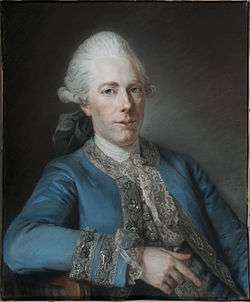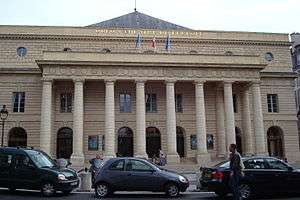Marie-Joseph Peyre

Marie-Joseph Peyre (1730 – 11 August 1785) was a French architect who designed in the neoclassical style.
Biography
He began his training in Paris with Jacques-François Blondel at l'École des Arts, where he met Giovanni Niccolo Servandoni and formed a lifelong friendship with Charles De Wailly. He won the Prix de Rome for architecture in 1751 and was a pensionnaire at the French Academy in Rome from 1753, where he was soon joined by De Wailly, the following year's winner, who brought with him Pierre-Louis Moreau-Desproux, whose sister Peyre eventually married. Peyre stayed in Rome until early in 1756, during the years when the students at the Academy were creating temporary projects in the new neoclassical manner.
In 1762 he built a villa for Mme Leprêtre de Neubourg in the southwest suburbs of Paris near the Gobelins; demolished in 1909, it is known only through the engravings in his Oeuvres d'architecture and two photographs taken in 1900 by Eugène Atget. It was an exercise in a purely Palladian manner, (Eriksen 1974:212, and pl. 48) quite unlike anything else done in France at that time.
In 1765 he produced a volume of Oeuvres d'Architecture de Marie-Joseph Peyre,[1] which he dedicated, as "the fruit of my studies in Italy", to the marquis de Marigny, Pompadour's brother, who had been carefully trained for his popsition as Directeur des Bâtiments du Roi, and was attuned to the new classicism in the arts. Peyre interspersed his own work with carefully drawn views and sections of Roman monuments, such as a reconstruction of the tomb of Caecilia Metella, not as it was to be seen in Rome, but as it had originally been connstructed.[2] Peyre included grand designs for an academy and for a cathedral that was quickly identifiable as a "purified" neoclassical rendering of St. Peter's. Peyre's volume added to the repertory of architectural design that fed Neoclassicism. A mark of its continued usefulness was its reissue in 1795, after his death, with a Supplement, composé d'un Discours sur les monuments des anciens[3] and its use by the English architect John Soane.[4] Partly on the credibility the publication lent him, Peyre was named architect at Fontainebleau in 1772, jointly with his friend Charles De Wailly.

From 1767 he worked with De Wailly on a project for the new Théâtre-Français, the present Théâtre de l'Odéon, Paris, which was at the heart of a complicated urbanistioc scheme battered by many conflicting interests.[5] De Wailly and Peyre were commissioned in 1767 to begin designs the project on the orders of Marigny, on the momentum gained by their joint success at the Opéra of Versailles. First designs were approved by the kind at the end of 1769, and revised designs the following spring; an arrêt in council, 26 March 1770, authorising the project's execution in the gardens of the former Hôtel de Condé. Further delays in acquiring additional land for the project, jointly financed by the King and the City of Paris, were partly occasioned by a long absence of Condé from 1771. De Wailly returned ti Italy and in his absence Marigny resigned; his successor, the abbé de Terray, championed a rival project urged by the City of Paris, that was the design, awkwardly enough, of Peyre's brother-in-law and De Wailly's friend from Roman days, Pierre-Louis Moreau-Desproux, now architect to the City of Paris. Thanks to the efforts of Monsieur, the Comte de Provence, brother of the king, the Peyre-De Wailly project was finally confirmed in 1778 with a slight modification to its planned orientation, to bring it into accord with the comte de Provence's residence, the Palais du Luxembourg. Work, on foundations already constructed by Moreau, began in May 1779, paid for by Monsieur, and by 16 February 1782, the players of the Comédie Française, who had objected to the project from the start, were installed in the new theatre, which was inaugurated by Marie-Antoinette, 9 April 1782, with a performance of Racine's Iphigénie.
Peyre was the architect of the Hôtel de Nivernais, rue de Tournon, which was praised by his former master Blondel[6] and the Hôtel de Luzy, rue Férou.
His portrait was painted by Marie-Suzanne Roslin, 1771.[7] Among his pupils were Charles Percier and Pierre-François-Léonard Fontaine and Jules de Mérindol. Peyre's younger brother, Antoine-Joseph Peyre (1739–1823),[8] and his son Antoine-Marie Peyre (1770–1843) were also architects.[9]
Notes
- ↑ A facsimile of the 1765 edition was published in 1967.
- ↑ (Getty Library) illustration
- ↑ Noted in Hanno-Walter Kruft, A History of Architectural Theory: From Vitruvius to the Present 1994, ch. 13, note 154.
- ↑ David Adhead, "'Like a Roman sepulchre': John Soane's design for a Castello d'acqua at Wimpole, Cambridgeshire, and its Italian origins", Apollo, (April 2003)(on-line text)
- ↑ The definitive account of the complicated proceedings is Monica Steinhauser and Daniel Rabeau, "Le Théâtre de l'Odéon de Charles de Wailly et Marie-Joseph Peyre" Revue de l'Art 19 (1973) pp 8-49; a summary is in Allan Braham, "Charles de Wailly and Early Neo-Classicism" The Burlington Magazine 114 No. 835 (October 1972), p 682f.
- ↑ Blondel, Cours d'architecture I,:110, noted in Robin Middleton, "Jacques François Blondel and the 'Cours d'Architecture'", The Journal of the Society of Architectural Historians 18.4 (December 1959, pp. 140-148) p 147, and note. Blondel also praised the Odéon, I:110 and II;270.
- ↑ Illustrated; sold at auction, 25 June 2003
- ↑ Winner of the Prix de Rome, 1762.
- ↑ Russell Sturgis, A Dictionary of Architecture and Building
References
- Eriksen, Svend, (Peter K. Thornton, translator), Early Neo-Classicism in France (London: Faber and Faber) 1974.
- Hautecoeur, Louis, Histoire de l'architecture classique en France IV (Paris: Picard) 1952:225ff.
- Piranèse et les français, 1740-1790 exhibition catalogue, 1976:266ff.
- Peyre, Marie-Joseph (1795). Oeuvres d'architecture de Marie-Joseph Peyre, second edition. Paris: chez l'Éditeur, rue des Poitevins. View at Gallica.
Dissertation sur la distribution des anciens comparée à celle des modernes, et sur la manière d'employer les colonnes